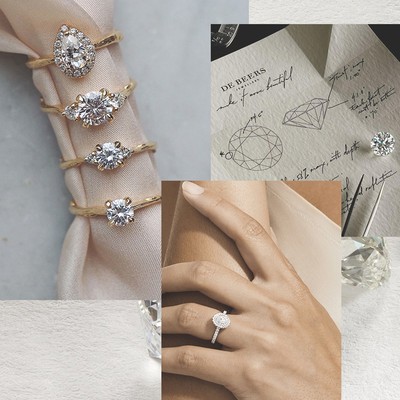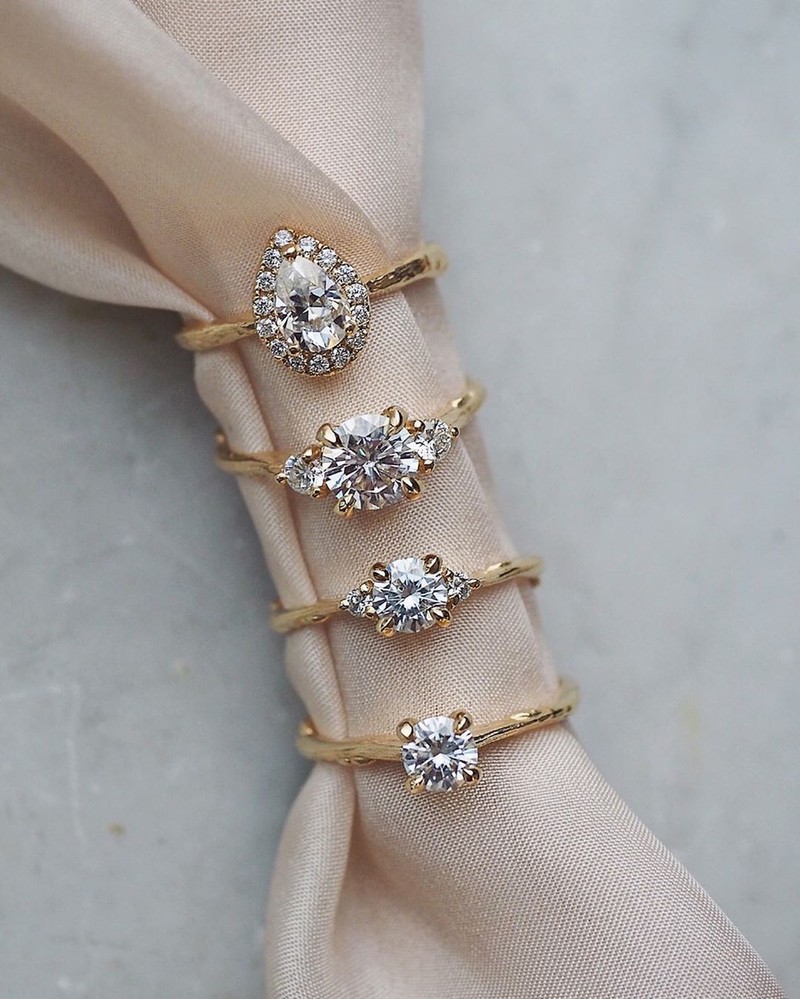
Buying Diamonds: Everything You Need To Know
Before you and/or your partner look for your ring, you need to know about the four most important aspects of buying a diamond. The ‘4Cs’ are cut, colour, clarity and carat weight. Together, they are a universal way of determining a diamond’s value and rarity.
“The 4Cs are an amazing starting point when choosing your ring, but don’t let them be the absolute deciding factor,” says Chupi Sweetman-Durney, founder and CEO of precious jewellery company Chupi. “This system of standardisation is applied to diamonds with the assumption that a standard cut and heavy stone, that is internally cleat and totally colourless, is the best there is. But we also recommend choosing your dream gemstone based on the feeling it gives you.”
Andrew Coxon, president of the De Beers Institute of Diamonds, confirms: “When we help you find your perfect diamond, we look beyond the 4Cs and recognise that, while two diamonds may appear identical on a laboratory grading report, in reality they may not be equally beautiful.”
“Before you do anything else, make sure you always choose your ring or diamond from a reputable dealer, and always get a certificate with any diamond you choose. Follow the rule: ‘If it’s cheap, it’s cheap for a reason.’ It is always better to spend money on a high-quality small diamond that will sparkle forever, than buy a cheap large-carat diamond that will look like a piece of glass,” advises Nigel O’Reilly, designer and master goldsmith at NOR Design.

“White diamonds sit somewhere on a scale of 23 subtle shades, from truly colourless to warmer whites. While colourless diamonds are very rare, it’s worth knowing that different shades can be more flattering on different people. This offers the exciting option of buying a much larger diamond than perhaps you thought possible,” says Andrew. “Yellow diamonds, for example, are saturated with nitrogen – the higher the saturation, the more intense their colour. Pink and red diamonds are formed when intense heat and pressure twist the diamond’s atomic lattice. The presence of boron is what gives blue diamonds their colour – this is the same element that can be found at the bottom of the sea.”
“With grey diamonds, morganites and emeralds, you want a colourful stone, but with white or classic diamonds you want a completely colourless stone,” says Chupi. “With a classic diamond the ‘colour’ grade is actually a defined scale of lack of colour."
“Diamonds are graded from ‘D’ (colourless) to ‘Z’ (tinted). A ‘D’ colour diamond is by far the most exceptional and one you can instantly recognise with its flashing blue-white brilliance,” says Nigel. “We like to use D-H, knowing the exceptional colour that comes from these stones. As you move down the scale, the colour becomes slightly tinted. As with the cut, you should choose your diamond based on what it looks like on your hand – sometimes you can find a larger tinted diamond that may suit your hand and skin tone even better. The tint of the diamond you choose can then become part of the overall design of your ring to make it truly exceptional and unique to you.”

“This is a measurement of weight, with 1
carat equal to 200mgs. While a larger diamond is usually considered more desirable, two diamonds of equal weight may have different values based on the other characteristics of the 4Cs,” advises Andrew.
“Carat is a measurement of weight, not love. It is simply what the precious stone weighs in metric carats, which are a unit of measurement like kilos or pounds,” explains Chupi. “While size is a pretty good indicator of carat, if you’re looking to maximise your stone size on your budget, a top tip is that oval stones will weigh less in carats than a similar-size round-cut stone, giving you a bigger visual impact for the same cost.”
“Size isn’t everything,” advises Nigel. “Choosing a smaller diamond with a better cut or clarity can result in a more elegant and beautiful stone. It is always best to view the diamond before choosing it on the basis of carat, especially if you are purchasing online or at auction, as you may be disappointed when you view it in the flesh.”

“Diamonds were created by extreme heat and pressure, deep within the earth, 720 million to 3.5 billion years ago,” says Andrew. “They contain internal traces of organic substances – these are called ‘inclusions’. Fewer inclusions equates to higher clarity but, as all the 4Cs influence each other, clarity can be balanced by colour.”
“With white or classic diamonds we look for no inclusions, but with grey diamonds we look for the most beautiful inclusions. Cultivated lab-grown diamonds and classic diamonds are clear, while other stones have the most beautiful, exciting inclusions,” says Chupi. “The diffusion of light from an internally clear stone is undoubtedly spectacular, but these stones are an incredibly rare natural phenomenon. We are committed to sustainable sourcing, and have been pondering the ethical considerations of mining. We have now added beautiful cultivated lab-grown diamonds into our collections as a more sustainable choice for our clients."
“A perfectly clear or flawless diamond is valuable for its extreme rarity. The diamonds we choose at NOR are visibly perfect to the eye, right up to flawless, ensuring the highest grade of clarity, with no visible inclusions,” says Nigel.

“While diamonds owe their beauty to nature, it is the shape and skilfulness of the polished cut that determines that all-important sparkle,” says Nigel. “The accuracy of the cut equals greater brilliance in the diamond. The cut of a diamond is a mathematical equation – to capture and refract light.”
“This is only one of the 4Cs that isn’t determined by nature. An expertly cut diamond with perfectly symmetrical and aligned facets will maximise sparkle by determining how it reflects light internally from one mirror-like surface to another,” adds Andrew. “It’s good to decide which shape of cut you prefer, then you should consider the shape of your hand and the length of your fingers – some cuts, like the oval shape, can be great for visibly elongating the finger.”
“As diamond setters, we believe the cut to be of paramount importance, even more than the carat,” says Nigel, “The popularity and stunning simplicity of a round brilliant diamond captures almost everyone’s imagination. But, as an engagement ring designer and maker, I love to choose an exceptional pear, emerald or ‘cushion cut diamond with a hint of colour.”
Ready To Go Shopping? Read Nigel’s Guide To Cuts First…
Round
A ‘round brilliant’ is a diamond cut in a particular circular form with numerous facets for exceptional brilliance. On its side, the round brilliant shape resembles that of a cone and provides maximum light return through the top of the diamond, hence it is the most popular traditional cut.
Oval
Oval-cut diamonds are simply an elongated round brilliant cut. They have the brilliance of the round diamond, but a more unique shape. They are a stunning diamond and, when cut well, can look larger than a round diamond. Many people love this diamond shape for another of its benefits: they can make fingers look narrower and longer; and complement a wide range of hand shapes and sizes.
Emerald
An emerald-cut diamond flaunts an elongated, rectangular shape and chiselled step cuts, with straight linear facets – usually arranged in parallel down the stone. To add stability and prevent fractures, the corners of an emerald cut are usually cropped. Emerald cuts are more prominent in rectangle but are available in square also. A popular choice for those wanting a larger stone without a high price point, an emerald-cut diamond usually appears bigger than other shaped diamonds in the same carat weight.
Radiant
The radiant cut was designed simply to combining the finest elements of the round brilliant cut and the emerald cut. It owes its brilliance to the 70 facets around its pavilion and crown. The precision of each facet offers immense brilliance. The top (table) of the radiant cut is actually slightly smaller than that of a round brilliant cut diamond of an equal carat weight. However, the radiant cut’s long diagonal measurement tricks the eye and makes it look larger than it really is.
Asscher
Asscher cuts look similar to emerald cuts – the most obvious difference being they are square not rectangular. This cut features large step facets and a high crown that produces a brilliance unlike any other diamond shape. In fact, diamond experts often refer to the shine and sparkle of an Asscher cut diamond as an ‘endless hallway of reflective mirrors’.


Cushion
The cushion cut diamond combines a square cut with rounded corners, much like a pillow (hence the name). This classic cut has been around for 200 years and for the first century of its existence was the most popular diamond shape. Traditional cushion cut diamonds return light in a chunkier pattern than modern cuts.
Princess
A princess cut diamond is traditionally a square diamond that offers excellent fire and brilliance. This shape is designed from the inverted pyramid of the rough diamond stone. Princess cuts are among the most brilliant of all diamond shapes and are generally the second most popular choice for engagement rings after the round brilliant.
Pear
Pear shaped (or teardrop) diamonds are unique shapes with a point at the top and a graceful curve at the bottom. They can be long and slender, or shorter and plump. Pears are one of only two diamond shapes that are not symmetrical both horizontally and vertically. They are beautiful, elegant and relatively rare.
Heart
The beauty of the heart shape is in its perfect symmetry, with each side being a mirror image of the other. If the heart shape is not cut to proportion, this may be the first thing you notice when you see the stone. This is why it is key that you pick a symmetrical stone with each half exactly alike in size and shape. It is important not to buy the diamond blind but to see the actual diamond before you purchase.
Marquise
The marquise diamond cut, also known as a navette, is rarely seen in the engagement ring world. A marquise cut diamond features 58 facets and an elliptical shape with pointed ends. It has been around for centuries and – though it is not as popular as the princess or round cuts – its traditional, long, narrow shape looks excellent on a ring finger.
DISCLAIMER: We endeavour to always credit the correct original source of every image we use. If you think a credit may be incorrect, please contact us at info@sheerluxe.com.

